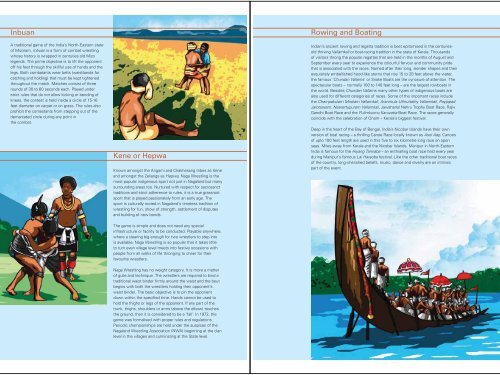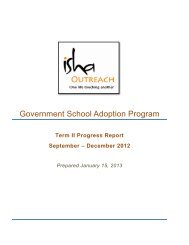Through The Power Of Sports Changing Lives - Isha Outreach
Through The Power Of Sports Changing Lives - Isha Outreach
Through The Power Of Sports Changing Lives - Isha Outreach
Create successful ePaper yourself
Turn your PDF publications into a flip-book with our unique Google optimized e-Paper software.
Inbuan<br />
A traditional game of the India’s North-Eastern state<br />
of Mizoram, Inbuan is a form of combat wrestling<br />
whose history is wrapped in centuries old Mizo<br />
legends. <strong>The</strong> prime objective is to lift the opponent<br />
off his feet through the skillful use of hands and the<br />
legs. Both combatants wear belts (waistbands for<br />
catching and holding) that must be kept tightened<br />
throughout the match. Matches consist of three<br />
rounds of 30 to 60 seconds each. Played under<br />
strict rules that do not allow kicking or bending of<br />
knees, the contest is held inside a circle of 15-16<br />
feet diameter on carpet or on grass. <strong>The</strong> rules also<br />
prohibit the contestants from stepping out of the<br />
demarcated circle during any point in<br />
the combat.<br />
Kene or Hepwa<br />
Known amongst the Angami and Chakhesang tribes as Kene<br />
and amongst the Zeliangs as Hepwa, Naga Wrestling is the<br />
most popular indigenous sport not just in Nagaland but many<br />
surrounding areas too. Nurtured with respect for sacrosanct<br />
traditions and strict adherence to rules, it is a true grassroot<br />
sport that is played passionately from an early age. <strong>The</strong><br />
sport is culturally rooted in Nagaland’s timeless tradition of<br />
wrestling for fun, show of strength, settlement of disputes<br />
and building of new bonds.<br />
Rowing and Boating<br />
Indian’s ancient rowing and regatta tradition is best epitomised in the centuriesold<br />
thriving Vallamkali or boat-racing tradition in the state of Kerala. Thousands<br />
of visitors throng the popular regattas that are held in the months of August and<br />
September every year to experience the colourful fervour and community pride<br />
that is associated with the races. Named after their long, slender shapes and their<br />
exquisitely embellished hood-like sterns that rise 15 to 20 feet above the water,<br />
the famous ‘Chundan Vallams’ or Snake Boats are the cynosure of attention. <strong>The</strong><br />
spectacular boats – normally 100 to 140 feet long – are the largest rowboats in<br />
the world. Besides Chundan Vallams many other types of indigenous boats are<br />
also used for different categories of races. Some of the important races include<br />
the Champakulam Moolam Vallamkali, Aranmula Uthruttathy Vallamkali, Payippad<br />
Jalotsavam, Neerettupuram Vallamkali, Jawaharlal Nehru Trophy Boat Race, Rajiv<br />
Gandhi Boat Race and the Pulimkunnu Karuvatta Boat Race. <strong>The</strong> races generally<br />
coincide with the celebration of Onam – Kerala’s biggest festival.<br />
Deep in the heart of the Bay of Bengal, India’s Nicobar Islands have their own<br />
version of boat racing – a thrilling Canoe Race locally known as Asol Aap. Canoes<br />
of upto 100 feet length are used in this five to six kilometre long race on open<br />
seas. Miles away from Kerala and the Nicobar Islands, Manipur in North-Eastern<br />
India is famous for the Hiyang Tannaba – an enthralling boat race held every year<br />
during Manipur’s famous Lai Haraoba festival. Like the other traditional boat races<br />
of the country, long-cherished beliefs, music, dance and revelry are an intrinsic<br />
part of the event.<br />
<strong>The</strong> game is simple and does not need any special<br />
infrastructure or facility to be conducted. Playable anywhere,<br />
where a clearing big enough for two wrestlers to step into<br />
is available, Naga Wrestling is so popular that it takes little<br />
to turn even village level meets into festive occasions with<br />
people from all walks of life thronging to cheer for their<br />
favourite wrestlers.<br />
Naga Wrestling has no weight category. It is more a matter<br />
of guile and technique. <strong>The</strong> wrestlers are required to bind a<br />
traditional waist binder firmly around the waist and the bout<br />
begins with both the wrestlers holding their opponent’s<br />
waist binder. <strong>The</strong> basic objective is to pin the opponent<br />
down within the specified time. Hands cannot be used to<br />
hold the thighs or legs of the opponent. If any part of the<br />
trunk, thighs, shoulders or arms (above the elbow) touches<br />
the ground, then it is considered to be a ‘fall’. In 1972, the<br />
game was formalised with proper rules and regulations.<br />
Periodic championships are held under the auspices of the<br />
Nagaland Wrestling Association (NWA) beginning at the clan<br />
level in the villages and culminating at the State level.




